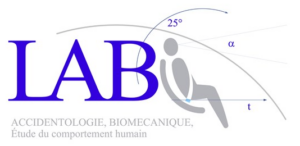LAB

Presentation
The Laboratoire d'Accidentologie, de Biomécanique et d'Etude du Comportement Humain (LAB) ((Laboratory of Accidentology, Biomechanics and the study of Human Behaviour) was created at the initiative of Claude Tarrière in 1969, the first example in Europe of two major car manufacturers, Renault and the former PSA Group, working together in a non-competitive field under the aegis of the PSA-Renault Economic Interest Group, to improve vehicle safety and contribute to the safety of road users. With more than 50 years of research in the three key areas of Accidentology, Impact Biomechanics and Driver Behaviour, the LAB has acquired know-how based on data collection, observation, analysis and anticipation. It participates in national and international studies and/or projects in order to share its expertise for the benefit of all road safety stakeholders and to acquire new knowledge and methodologies in cutting-edge fields (new forms of mobility, automated driving, connected services, etc.). LAB is a major contributor to the production of scientific publications and analysis files for future regulations, EuroNCAP protocols and standards (ISO, CEN, etc.).
Projects / Use Cases
As a partner in the SCORE@F (2011), SCOOP (2014) and InDiD (2019) projects, LAB has developed recognised expertise in impact studies relating to the contribution of connectivity in various use cases involving road safety issues.
Ex-ante evaluation study of the accidental stakes of use cases such as road works, unexpected and dangerous events to be managed, etc.
Several impact studies:
- Study of the behaviour of drivers of connected vehicles (Naturalistic Driving Study (NDS) and Field Operational Test (FOT) in the Paris region, Brittany and Bordeaux);
- Evaluation of the accident risk and benefits of road safety-related use cases.
- Evaluation of the acceptability of C-ITS services by receiving/transmitting warning and information messages, using various opinion-gathering processes: interviews before and after testing; focus groups to gather users’ opinions and suggestions for improvement; expert assessments.
Ex-ante evaluation of accident-related issues for the new use cases: A, B, C (signposting, signage), D, E, G (intersections), H (traffic management), I (vulnerable road users), K (level crossings), L (law enforcement)
Contribution of expertise to evaluation studies on:
- The behaviour of drivers using the COOPITS application in Bordeaux (several use cases considered) (Cerema).
- The behaviour of drivers using connected services at level crossings and cognitive load, on a simulator (use cases B, C, D, G, I, K) (SNCF).
- The contribution of connectivity to the automated vehicle in a lane insertion situation (use cases G5, G6) (VEDECOM).
- The distraction of road operations agents using the “SCOOP” application (several use cases envisaged) (Cerema).
Find out more about the projects:
Timeline
InDiD : 2019 – 2023
Generic contacts - services
Stéphane BUFFAT, LAB Director: stephane.buffat@lab-france.com
Cyril CHAUVEL, LAB Deputy Director: cyril.chauvel@stellantis.com
Laura BIGI, Accident Analysis Manager: laura.bigi@stellantis.com
Jean-Baptiste HAUE, Expert & Head of Driver Behaviour Studies: jean-baptiste.haue@lab-france.com